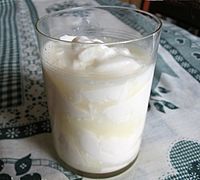Soured milk facts for kids

Russian and Ukrainian prostokvasha (kysliak), traditional fermented milk
|
|
| Main ingredients | Milk |
|---|---|
Soured milk is a group of food products made from milk that has become tart. This tart taste comes from making the milk more acidic. Milk can become acidic in two main ways. One way is through tiny living things called bacteria. This process is called fermentation. The other way is by adding an acid directly, like lemon juice or vinegar.
When milk becomes acidic, it gets thicker. This also helps stop bad bacteria from growing. This makes the soured milk last longer.
Contents
How Milk Becomes Sour
Milk that turns sour because of bacteria is often called fermented milk or cultured milk. Long ago, people would just leave fresh milk in a warm spot. After a day, it would naturally ferment and become sour. Today, soured milk you buy in stores might be made differently than milk that sours on its own.
Acidified Milk
Sometimes, soured milk is made by adding an acid. This can be done with or without adding bacteria. In the United States, many different acids are used to make acidified milk. These include acetic acid (found in vinegar) and citric acid (found in lemon juice). Other acids like lactic acid or phosphoric acid can also be used.
Where Soured Milk is Popular
Soured milk is a very common food in many parts of the world. It is often made at home or sold in stores.
Soured Milk in Europe
You can find soured milk all over Europe. It is especially popular in Eastern Europe. Countries like Bulgaria, Russia, Ukraine, and Poland enjoy it. It is also a favorite in countries that used to be part of Yugoslavia. These include Serbia and Croatia. Other European countries like Romania, Hungary, Greece, and Finland also consume soured milk.
Soured Milk in Africa
Soured milk is also popular in parts of Africa. People in the Great Lakes region of Somalia and East Africa enjoy it. This includes countries like Kenya, Uganda, and Tanzania. It is also a traditional food for the Bantu people in Southern Africa.
Soured Milk in Cooking
Fresh milk that has not turned sour is sometimes called "sweet milk." This is because it contains a sugar called lactose. When milk ferments, bacteria change this lactose sugar into lactic acid. Lactic acid is what gives soured milk its tart flavor.
Before refrigerators were invented, milk often turned sour before people could drink it all. Because of this, many old recipes use soured milk as an ingredient. Soured milk made by fermentation tastes different from milk made sour by adding acid. This is because the acids added in stores have different flavors. Also, fermentation can create new and interesting flavors.
Today, buttermilk is a common substitute for milk that has naturally soured.
See also
 In Spanish: Leche agria para niños
In Spanish: Leche agria para niños

